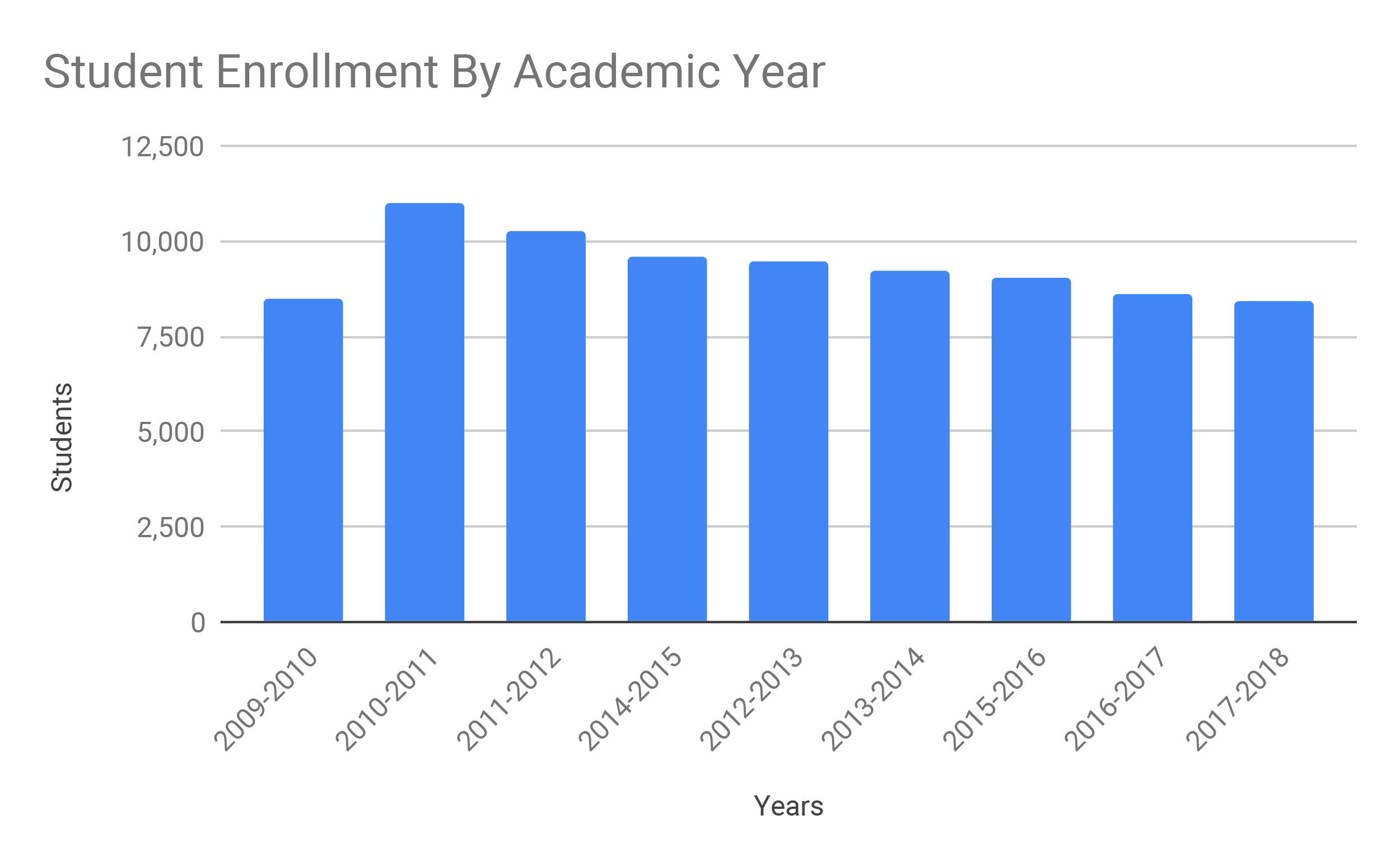“Please make sure to let your friends know about this class- students enrolled for this class is looking low winter quarter and I don’t want to lose my job.”
A history teacher last quarter mentioned this a couple times toward the end of fall quarter last year, in a joking yet serious manner.
Why was he so worried?
Are less and less students attending community colleges or post high school institutions in general? Is it common for less students to want to go to school winter quarter? Let’s take a look at some SFCC statistics to find out.
The following numbers are from enrollments dating back to 2009 to just last year, 2018, provided by SFCC’s website. Unfortunately this year’s numbers will not be available until next year.
See the graph to the right for more information on enrollment.
SFCC’s highest annual attendance was in the 2010-11 school year at 11,004, compared to the lowest annual attendance of 8,440 in just the past 2017-2018 school year. That is over a 3,000 student average attendance loss for SFCC. Enrollment has slowly been declining since.
Other knowledge that can be gained from the reports is that tuition cost slowly started costing more after the 2009-10 school year. It started at $2,902 per quarter for a full-time student and now from last year’s statistics it is at about $3,927 per quarter for the average full-time student at SFCC.
A fellow student spoke about the matter.
Conner Crowe, 22, a third year SFCC student, started going to SFCC after graduating high school in 2015. His plan is to major in visual communications and web design/development. Conner took on a bigger load than some other students, taking over 20 credits during a couple quarters, paying rent and working a full-time job. It started to become a little too much to handle, so unfortunately he didn’t do as well as he hoped spring quarter of 2018 and ended up dropping out of a class. He decided to switch up his methods and is now taking two classes on campus- one being a hybrid.
His busy life outside of school led him to take the online route which he does think is a little bit harder and even more time consuming but he’s making it work. He had debated transferring to Eastern Washington University, but juggling school, work and other activities was becoming overly stressful. It didn’t seem so worth it when he could accomplish the same thing here for half the cost and commute. He had to make the sacrifice to do mostly online classes over on campus classes here at SFCC. His hopes is to easily find a “big boy job” after completing his degree.
Rachel Kaiser, 20, is only taking SFCC online classes through the online learning system. This is her first year at SFCC after taking two years off after high school. When asked why she chose to do online rather than on-campus classes, her answer did not come as a surprise: time. Rachel, who also works a full time job, is involved in several time-consuming hobbies such a youth group and traveling, and lives on her own. Going to school on campus would mean less time to do other things and most likely a cut in hours at her job. Doing online classes is easier for her and suits her lifestyle more adequately, she said. She is still a little unsure of plans on her desired career, but is in the process of getting her associate degree to have something under her belt and hopefully soon she’ll have decided what career path she’ll want to go down.
Needless to say, online learning has certainly increased within the past few years due to our busy lives. That may be a contribution to the slightly noticeable lack of students on campus. Now if we take a look at quarterly statistics individually, there are also other factors that can be concluded that are affecting student’s enrollment.
Since the majority of students start school in fall, endure it through winter, and end in spring, those are going to be the quarters that will be prioritized.
According to the data provided on SFCC’s website, less people deciding to go to college doesn’t seem to be the problem. In fact, first-time students in the 2013 fall quarter was about made up 2.9 percent of the students enrolled. In 2017’s fall quarter the number was significantly higher at about 27.3 percent. If anything, more and more people are choosing to take post-secondary education for the first time. The numbers do clearly show however that less students are willing to finish out the school year; the number of students enrolled drop from fall to winter quarter every year.
Looking just at last year’s (2017-18) number of students employed seems to correlate and justify enrollment as well. The amount of students enrolled decreased as the amount of students employed in full-time jobs increased.
In Fall 2017, of the 5,924 students enrolled, 667 of them were employed full time. This differs from Spring 2018, when 5,320 students were enrolled, with 710 of employed full time.
Overall, if we just take a look five years back to the school year 2013-14 to the latest of 2017-2018 we can see changes in the quarterly demographics of students attending SFCC.
2013-2014
Fall: 6,051
Winter: 6,059
Spring: 5,680
2014-2015
Fall: 6,405
Winter: 6,143
Spring: 5,861
2015-2016
Fall: 6,232
Winter: 5,693
Spring: 5,450
2016-2017
Fall: 6,028
Winter: 5,572
Spring: 5,485
2017-2018
Fall: 5,924
Winter: 5,667
Spring: 5,320
It appears that last year started out with a slightly lower number than usual and has slowly been decreasing over the past four years, starting out with 6,405 fall quarter of 2014 to 5,942 fall quarter of 2017. Every year shows that more students stop coming after fall quarter. An average of 569 student from 2013-18 have stopped enrolling or dropped out after the fall quarter.
Maybe it’s the colder weather, preferring to work over attending school, choosing an alternate form of education such as online, or the lack of motivation; whatever it may be, if you have noticed less students on campus that’s because there certainly has been.



